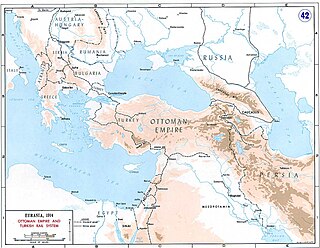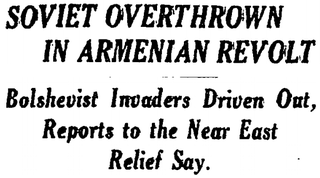 W
WAmbassador Morgenthau's Story (1918) is the title of the published memoirs of Henry Morgenthau Sr., U.S. Ambassador to the Ottoman Empire from 1913 to 1916, until the day of his resignation from the post. The book was dedicated to the then U.S. President Woodrow Wilson, and it took over two years to complete. The ghostwriter for Henry Morgenthau was Burton J. Hendrick; however, a comparison with official documents filed by Morgenthau in his role as ambassador shows that the book must have been structured and written extensively by Morgenthau himself.
 W
WArmenian battalions refer to military units formed by Armenian volunteer conscripts, mostly fighting against the Ottoman forces:1912-13, Balkan Wars, an auxiliary battle group in Bulgarian Army. 1914-17, World War I, Armenian volunteer units were employed in the Russian Imperial Army 1914-17, World War I, Armenian volunteer units were employed in the Egyptian Expeditionary Force of British Army. 1916-20, World War I, French Armenian Legion were employed in the French Army. The unit was active in Adana and Arara. 1940-45, World War II, Armenian Legion.
 W
WThe Armenian national liberation movement aimed at the establishment of an Armenian state. It included social, cultural, but primarily political and military movements that reached their height during World War I and the following years.
 W
WOttoman Armenian casualties refers to the number of deaths of Ottoman Armenian people between 1914 and 1923. Armenia and several other nations recognize the deaths to have occurred during an Armenian Genocide. Most estimates of related Armenian deaths between 1915 and 1918 range from 800,000 to 1.5 million.
 W
WThe Russian Caucasus Army of World War I was the Russian field army that fought in the Caucasus Campaign and Persian Campaign of World War I. It was renowned for inflicting heavy casualties on the opposing forces of the Ottoman Empire, particularly at the Battle of Sarikamish. It was also known for its extremely diverse ethnic composition, consisting of units from throughout the Russian Empire and both soldiers and officers from the many ethnic communities settled since the 1877-78 Russo-Turkish War in the militarily administered Kars Oblast in the Russian Transcaucasus. These included Georgians, Caucasus Greeks, and Armenians - the latter in particular strongly represented among both the soldiers and senior officers - as well as ethnic Russians and Ukrainians.
 W
WThe Caucasus campaign comprised armed conflicts between the Russian Empire and the Ottoman Empire, later including Armenia, Azerbaijan, Georgia, the Mountainous Republic of the Northern Caucasus, the German Empire, the Central Caspian Dictatorship, and the British Empire, as part of the Middle Eastern theatre during World War I. The Caucasus campaign extended from the South Caucasus to the Armenian Highlands region, reaching as far as Trabzon, Bitlis, Mush and Van. The land warfare was accompanied by naval engagements in the Black Sea.
 W
WThe Caucasus Viceroyalty was Imperial Russia's administrative and political authority in the Caucasus region exercised through the offices of glavnoupravlyayushchiy and namestnik (наместник). These two terms are commonly, but imprecisely, translated into English as viceroy, which is frequently used interchangeably with governor general. More accurately, glavnoupravljajuščij is referred to as High Commissioner of the Caucasus, and namestnik as Viceroy.
 W
WEstablished in December 1917, Dunsterforce was an Allied military force named after its commander, General Lionel Dunsterville. The force had fewer than 350 Australian, New Zealand, British and Canadian officers and NCOs, who were drawn from the Western and Mesopotamian fronts. The force was intended to organise local units in northern Iran (Persia) and southern Caucasus, to replace the Tsarist armies that had fought the Ottoman armies in Armenia. The Russians had also occupied northern Iran in co-operation with the British occupation of south Iran, to create a cordon to prevent German and Ottoman agents from reaching central Asia, Afghanistan and India.
 W
WThe February Uprising was an anti-Bolshevik rebellion by the nationalist Armenian Revolutionary Federation which started on February 13 and was suppressed on April 2, 1921 by the recapture of Yerevan by Bolshevik forces.
 W
WThe First Nagorno-Karabakh War was an ethnic and territorial conflict that took place from the late 1980s to May 1994, in the enclave of Nagorno-Karabakh in southwestern Azerbaijan, between the majority ethnic Armenians of Nagorno-Karabakh backed by Armenia, and the Republic of Azerbaijan. As the war progressed, Armenia and Azerbaijan, both former Soviet Republics, entangled themselves in protracted, undeclared mountain warfare in the mountainous heights of Karabakh as Azerbaijan attempted to curb the secessionist movement in Nagorno-Karabakh. The enclave's parliament had voted in favor of uniting itself with Armenia and a referendum, boycotted by the Azerbaijani population of Nagorno-Karabakh, was held, whereby most of the voters voted in favor of independence. The demand to unify with Armenia began in a relatively peaceful manner in 1988; in the following months, as the Soviet Union disintegrated, it gradually grew into an increasingly violent conflict between Armenians and Azerbaijanis, resulting in ethnic cleansing, with the Sumgait (1988) and Baku (1990) pogroms directed against Armenians, and the Khojaly Massacre (1992) directed against Azeris being notable examples. Inter-ethnic clashes between the two broke out shortly after the parliament of the Nagorno-Karabakh Autonomous Oblast (NKAO) in Azerbaijan voted to unify the region with Armenia on 20 February 1988. The declaration of secession from Azerbaijan was the final result of a territorial conflict regarding the land. As Azerbaijan declared its independence from the Soviet Union and removed the powers held by the enclave's government, the Armenian majority voted to secede from Azerbaijan and in the process proclaimed the unrecognized Republic of Nagorno-Karabakh.
 W
WThe First Republic of Armenia, officially known at the time of its existence as the Republic of Armenia, was the first modern Armenian state since the loss of Armenian statehood in the Middle Ages.
 W
WThe flag of the Armenian SSR was adopted on 17 December 1952 by the government of the Armenian SSR. The flag is similar to the flag of the Soviet Union but has a ¼-width horizontal blue stripe in the middle. The red represents the "revolutionary struggle of the working masses" and the golden hammer and sickle represents the peasants' and workers' union.
 W
WThe 119th Separate Tank Regiment, popularly known as the Sassuntsi-Davit Tank Regiment was a decorated Soviet separate tank regiment during the Second World War, consisting primarily of ethnic Armenians. The unit was named after David of Sasun, the hero of the medieval Armenian national epic Daredevils of Sasun.
 W
WThe Republic of Mountainous Armenia, also known as simply Mountainous Armenia, was an anti-Bolshevik Armenian state roughly corresponding with the territory that is now the present-day Armenian provinces of Vayots Dzor and Syunik, and some parts of the present-day Republic of Azerbaijan. It was established by military commander and Armenian political thinker Garegin Nzhdeh and his allies with the support of local guerrilla forces, following the suppression of the February Uprising in April 1921. It was not recognized by any country but existed until mid-July of the same year.
 W
WThe partition of the Ottoman Empire was a geopolitical event that occurred after World War I and the occupation of Constantinople by British, French and Italian troops in November 1918. The partitioning was planned in several agreements made by the Allied Powers early in the course of World War I, notably the Sykes-Picot Agreement, after the Ottoman Empire had joined the Ottoman–German Alliance. The huge conglomeration of territories and peoples that formerly comprised the Ottoman Empire was divided into several new states. The Ottoman Empire had been the leading Islamic state in geopolitical, cultural and ideological terms. The partitioning of the Ottoman Empire after the war led to the domination of the Middle East by Western powers such as Britain and France, and saw the creation of the modern Arab world and the Republic of Turkey. Resistance to the influence of these powers came from the Turkish National Movement but did not become widespread in the other post-Ottoman states until the period of rapid decolonisation after World War II.
 W
WThe Persian Campaign or Invasion of Iran was a series of engagements in Iranian Azerbaijan region involving the forces of the Ottoman Empire against those of the British Empire and Russian Empire, and also involving local Persian population elements, beginning in December 1914 and ending with the Armistice of Mudros on October 30, 1918, as part of Middle Eastern theatre of World War I.
 W
WThe Republic of Aras was a short-lived and unrecognized state in the South Caucasus, roughly corresponding with the territory that is now the Nakhchivan Autonomous Republic of Azerbaijan. Named after the Aras River that formed its southern border, the republic was declared in December 1918 by Jafargulu Khan Nakhchivanski with support from the Azerbaijan Democratic Republic's ruling party, the Musavat Party, and the government of the Ottoman Empire.